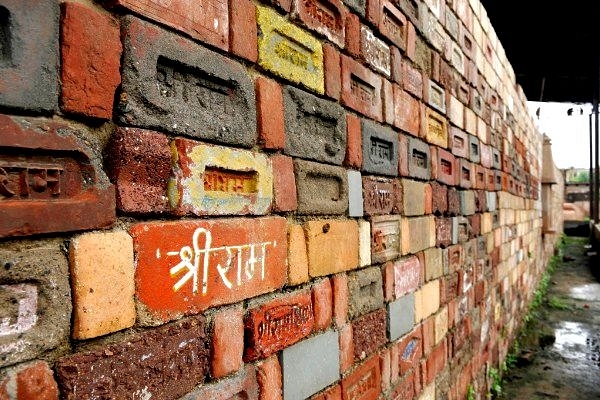Politics
Ayodhya Trust Must Create Governance Model For Running Temples Anywhere
- The Ram Mandir Trust should set the right precedents and create a strong template for running temples efficiently and transparently.
- It should not become another government-run bureaucracy, with scandals dogging it at every turn.

Bricks with Sri Ram written on them in Ayodhya. (Burhaan Kinu/Hindustan Times via GettyImages)
Even as the Home Ministry has begun preparatory work for setting up the trust that will build the Ram temple in Ayodhya, there is a growing clamour from assorted mahants, sadhus, seers and religious heads to get a seat on it. Some people have demanded that the trust be headed by Yogi Adityanath, Chief Minister of Uttar Pradesh.
The Union government, which has been mandated to set up the trust that will oversee the construction of the massive temple, should actually look for talent elsewhere. These could include religious-minded Hindu technocrats who have the gravitas, credibility and integrity to not only build the temple in good time, but also put in place the necessary governance principles that will stand the temple in good stead over the long run.
Let’s be clear. The Ram temple in Ayodhya, the first major temple to be built in northern India for centuries, will be a huge money gusher as devotees congregate by the million every year after it is built. It has to set the right precedents for temple management and governance. It cannot be built or run efficiently by having assorted mahants and seers and politicians as its leadership team.
Since running temples is not the job of the government as well, the logical way to man the trust is to put someone like, say, E Sreedharan (of Delhi Metro fame) as its head, supported by a strong project management team and temple architecture and facilities experts.
There could, additionally, be special advisory committees for handling other aspects of building and operating the temple. These could include crowd management, security and premises management, financial management, creation of governance and transparency protocols, manuals for priests, sponsorship and development of Veda pathshalas, and overall development of the infrastructure around the temple. Many tourist hotels and related transport and physical infrastructure will have to come up to handle the millions who will flock the temple – which means the state government and district and municipal officials have to be involved in some committees. Ayodhya thus needs a plan that goes beyond just building the temple. Some lessons can be learnt from the Tirupati temple, which handles that kind of crowds and generates huge revenues.
This does not mean that the mahants and seers and sadhus have no role. They can, and should, be accommodated in some kind of advisory capacity when issues relating to the conduct of religious ceremonies and pujas inside the temple come up for discussion. They can also have a role in selecting the kind of priests who will run the temple, and train future priests for future employment at the temple. They can run religious courses and Veda pathshalas in the extended premises. What they should not be allowed to do is interfere in the day-to-day administrative and governance structures of the temple, once the broad contours are set.
The Ram Mandir Trust should set the right precedents and create a strong template for running temples efficiently and transparently, something that can serve as a model for other temples, especially temples retrieved from the arms of a rapacious state, particularly in southern India.
It should not become another government-run bureaucracy, with scandals dogging it at every turn.
Support Swarajya's 50 Ground Reports Project & Sponsor A Story
Every general election Swarajya does a 50 ground reports project.
Aimed only at serious readers and those who appreciate the nuances of political undercurrents, the project provides a sense of India's electoral landscape. As you know, these reports are produced after considerable investment of travel, time and effort on the ground.
This time too we've kicked off the project in style and have covered over 30 constituencies already. If you're someone who appreciates such work and have enjoyed our coverage please consider sponsoring a ground report for just Rs 2999 to Rs 19,999 - it goes a long way in helping us produce more quality reportage.
You can also back this project by becoming a subscriber for as little as Rs 999 - so do click on this links and choose a plan that suits you and back us.
Click below to contribute.
Latest